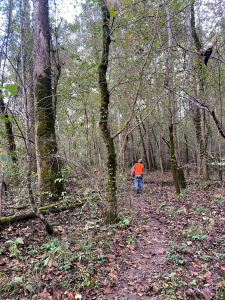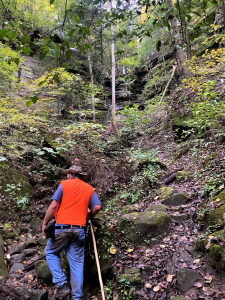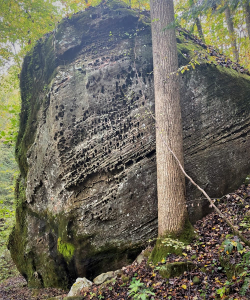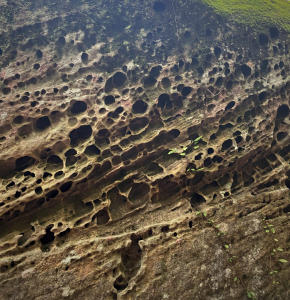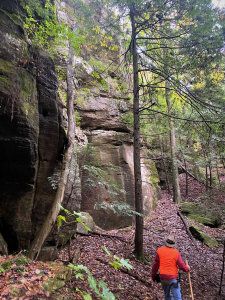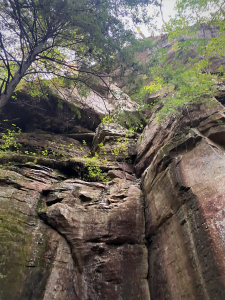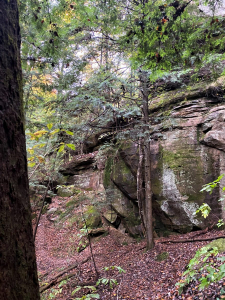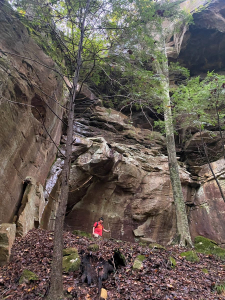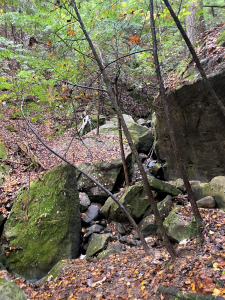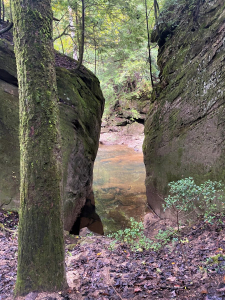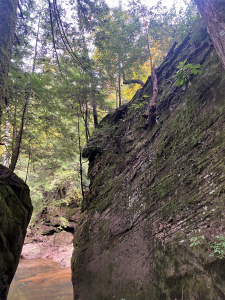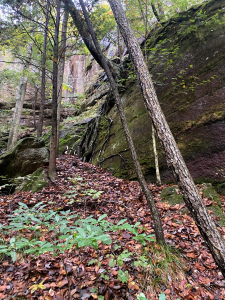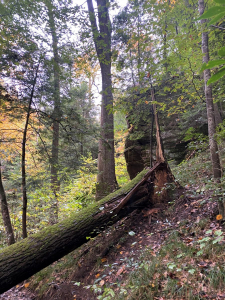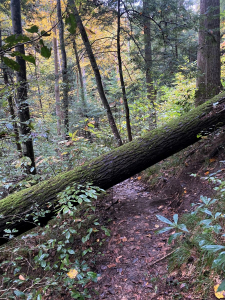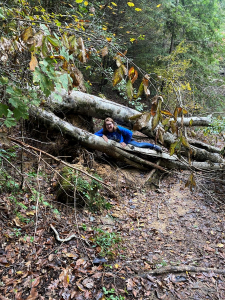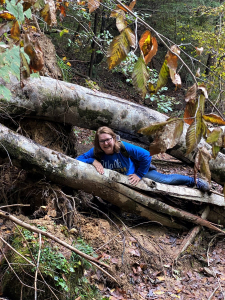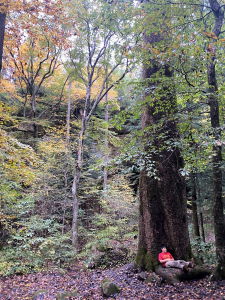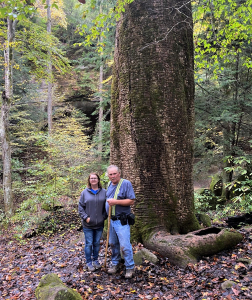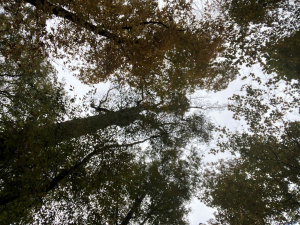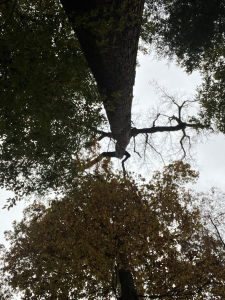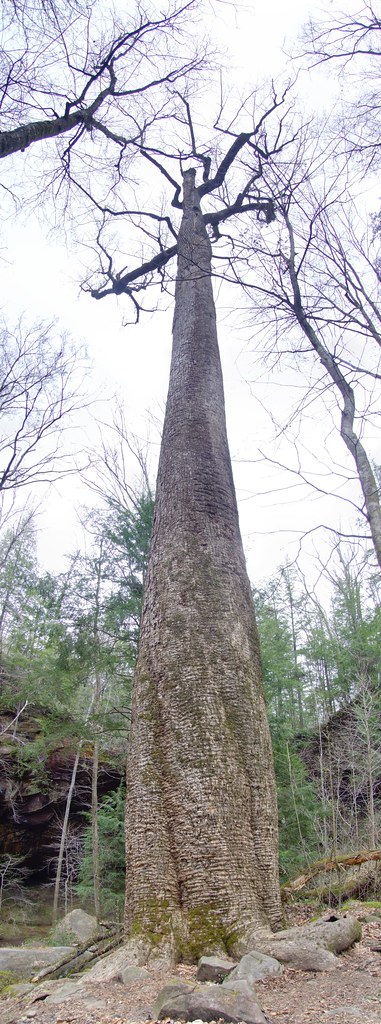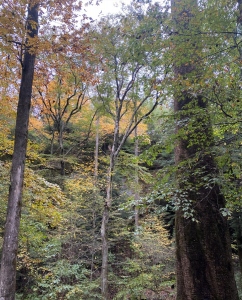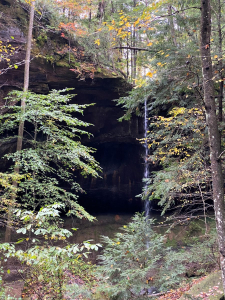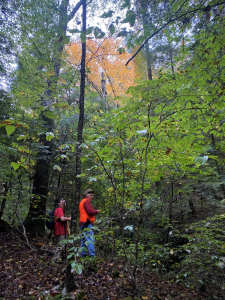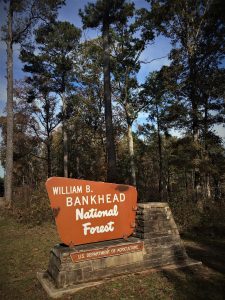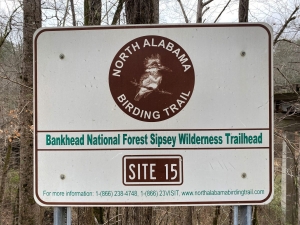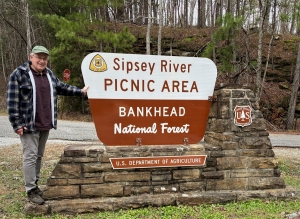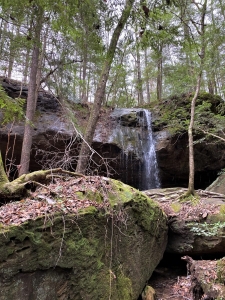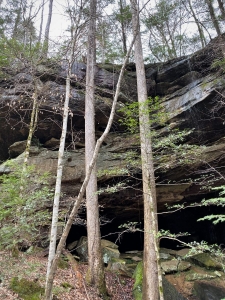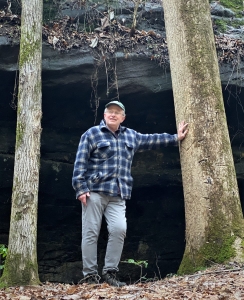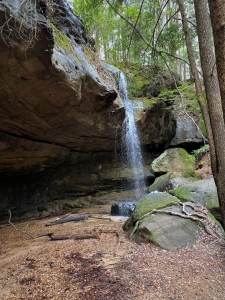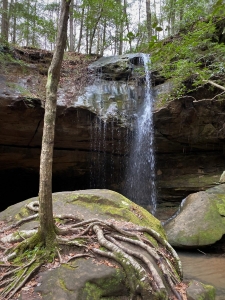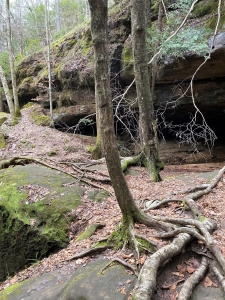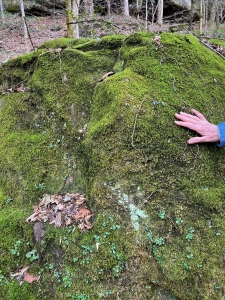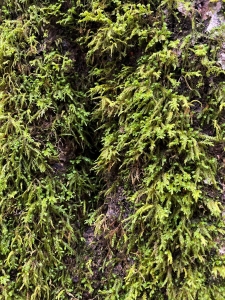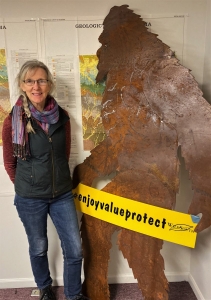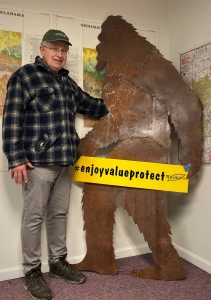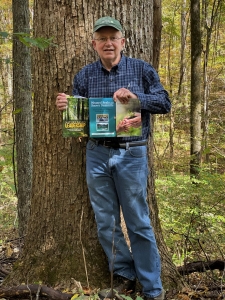Side Highlights on My Hike to Sipsey Wilderness Big Tree
October 30, 2021, I hiked to the Big Tree in Alabama’s Sipsey Wilderness, Bankhead National Forest. This Post offers photos and reflections on the special sidelights I saw along the way. See my previous related Post offering reflections on the rough and bouldered terrain, torturous blowdowns, and the majesty of the Big Tree: https://stevejonesgbh.com/2021/12/08/an-eleven-mile-bucket-list-hike-to-the-sipsey-big-tree/
Once more I remind readers that much of Nature’s beauty, magic, wonder, and awe lies hidden in plain sight. My referenced prior Big Tree Post focused on the more obvious surroundings: deep canyons; shear rock faces; boulder tumbles; too-dense blowdowns; ancient forests; streams and waterfalls. However, I’ve learned that by paying attention to only the obvious we miss so much that merits noticing. This was my first hike with Randy, Tara, and Jonathan. I believe that I helped open their eyes to features, both large and small scale, that they normally do not see. Among those things they had not previously been aware, we stopped to admire all manner of fungi along our route.
Destination
The Big Tree did not disappoint. I shall carry its image, serenity, and sacred spirit with me forevermore. I felt small, insignificant, and humble in its presence. At the same time, inspiration enveloped me. In fact, because of the aura of The Tree, a certain essence permeated the entire route…and all we saw, discussed, and encountered along the way.
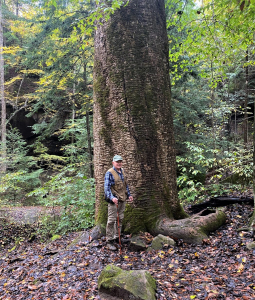
Magic peeped through the canopy, as a black birch in fall regalia declared autumn to those of us trekking along the forest floor. A golden skylight welcoming us, a glowing beam of promise penetrating the deep forest gloom that those less enchanted with the forest might perceive. Rain-soaked foliage, muted drippings, and saturated air — such is the solace of sheltered canyon forests in these humid climes. For me, forest gloom is an oxymoron. Even on the darkest, cloudiest days, the sun bursts above the clouds. So, too, does the birch proclaim that all is well within and beneath the canopy.
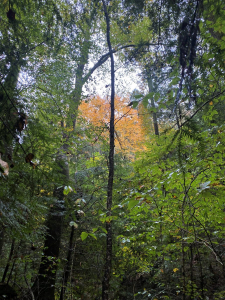
I consider myself easily impressed by Nature’s visual (as well as auditory and olfactory) gifts. I want to remain so, effortlessly spellbound by Nature’s ordinary, everyday wonder…all elements sublime upon close inspection. Albert Einstein expressed it well:
There are only two ways to live your life. One is as though nothing is a miracle. The other is as though everything is a miracle.
I view every walk in Nature as a sequential inventory and catalog of miracles. Nothing in Nature is ordinary to the observant and curious mind. Einstein implored us to look deeply into Nature:
Look deep into nature, and then you will understand everything better.
Special Treats
Shear rock faces appear barren and bereft of life…unless we seek hidden treasures. Judy and I fell in love with oak leaf hydrangeas as ornamental landscape plantings when we lived in Auburn, Alabama 1996-2001. I learned during our tenure there that the Sipsey Wilderness is the epicenter of Hydrangea quercifolia‘s natural range. We saw hundreds (thousands?) of individuals along our trek, each one special in its own way. Yet, none rose to the glory of the individual below, perched thirty feet above us on a narrow rock ledge, centered in the magnified photo (right). Nature does indeed abhor a vacuum. Any port in a storm will do. Our moderate climate with its ample and reliable rain provides a generally superb growing environment. Throw in a deep, sheltered canyon…and life abounds, even in a seeming-inhospitable crag.
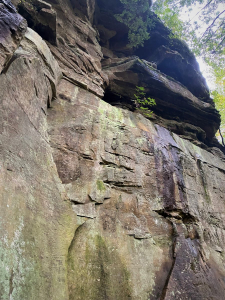
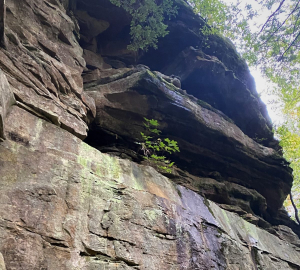
We stumbled upon just two small colonies of weak-leaf yucca, a plant I have not seen often in the wild. Its name derives from the fact that its foliage will bend and fold with just its own weight.
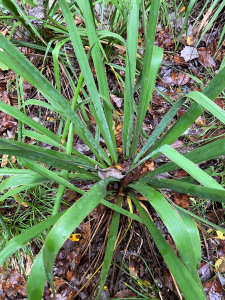
Fungi Panoply
Two-thirds of an inch of rain had fallen during the three days prior to our hike. Mild conditions had prevailed. Our friends in the fungi kingdom flourish in this kind of early fall weather. We found this mossy, dead and down woody debris covered in pear-shaped puffballs, each one about an inch in diameter. Their meat still pure white, these would have been at peak bite-size edibility, lightly flowered and simmered in butter! Because we were in a formal Wilderness, we foraged nothing. Puffballs are the fruiting bodies (spore-producing organ) of the decay fungi working within the dead log.
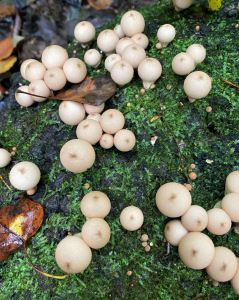
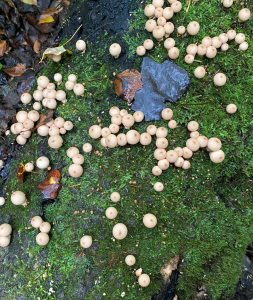
I thought for sure I had encountered a mushroom (two photos below) not much different from the puffballs. In fact, here’s what I wrote before investigating more carefully: “Similarly structured and functioning, these wolf’s milk mushrooms likewise occupied a dead and down log. The pinkish colors demanded our attention!” Boy, was I due for an awakening — here’s what I found online at TexasMushrooms:
Lycogala epidendrum, commonly known as wolf’s milk, groening’s slime is a cosmopolitan species of myxogastrid amoeba which is often mistaken for a fungus. The aethalia, or fruiting bodies, occur either scattered or in groups on damp rotten wood, especially on large logs, from June to November. These aethalia are small, pink to brown cushion-like globs. They may excrete a pink paste if the outer wall is broken before maturity. When mature, the colour tends to become more brownish. When not fruiting, single celled individuals move about as very small, red amoeba-like organisms called plasmodia, masses of protoplasm that engulf bacteria, fungal and plant spores, protozoa, and particles of non-living organic matter through phagocytosis.
Quite simply, what I had assumed was another mushroom is a slime mold. My copy of Mushrooms of the Southeast reports:
Wolf’s milk is one of the most widely distributed and well-known slime molds. The fruiting bodies resemble small puffballs. If an immature fruiting body is squeezed or broken open, a slimy pink substance with the consistency of toothpaste oozes out.
Nature presents novices like me a lifetime of learning every time I venture into the wild.
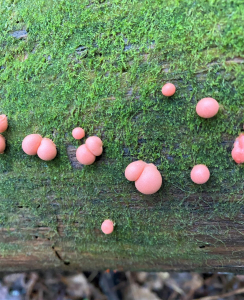
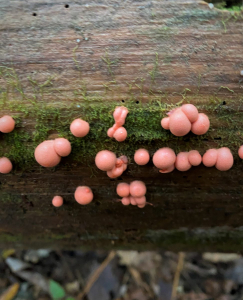
My fellow travelers, I believe, could be converted into forest fungi (or slime mold) enthusiasts. They found exquisite beauty in this violet-toothed polypore, another decay fungi, this one sporting a mushroom absolutely unlike either of the two organisms above.
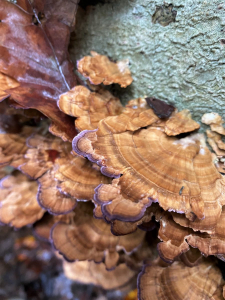
Alongside the violet-toothed polypore, we found another mushroom, this one identified by iNaturalist as agaricomycetes. I was pleased to have a positive identity…until I discovered a reference source offering this gem (paraphrased): agaricomycetes is a class of fungi that includes 17 orders, 100 families, 1147 genera, and 20,951 species. Well, it appears I have much to learn!
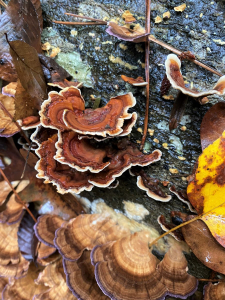
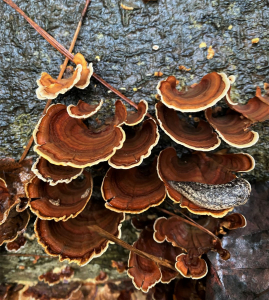
Mosses
I recall in days past hiking the muskeg of southeast Alaska, exploring the Tongass National Forest, and wandering the 400-year-old stand at Heart’s Content Natural Area in northwest Pennsylvania. Mosses abound in water-rich temperate forests. As we trekked the relatively flat riparian forest before reaching our vehicles, we found tree skirt moss rivaling the thick drapes hanging from Sitka Spruce on the lower slopes of Mount Verstovia in Sitka, Alaska (see photo under the two images immediately below) and the other areas I mentioned. These special places are life-rich, luxuriant ecosystems, as are the quiet canyons of our Sipsey Wilderness.
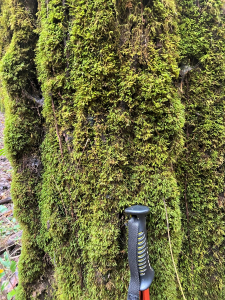
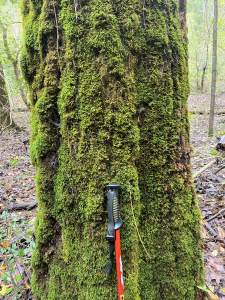
Moss-draped Sitka spruce near Sitka, Alaska June 2006.
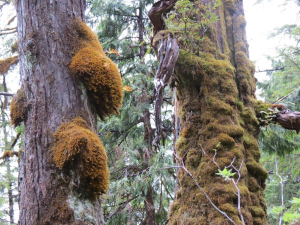
Once again, magic, beauty, wonder, and awe lie within plain sight no matter where I wander. A volume of miracles awaits discovery.
Tree Form Curiosities
I asked Tara to rest on this full-basal beech burl to demonstrate scale. Note it moss skirt. I’ve yet to meet a burl that did not intrigue me…nor stand as an object of my fascination.
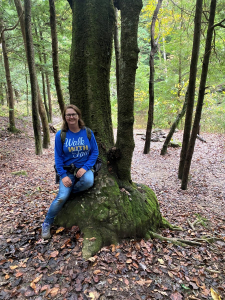
This birch took root atop a boulder, grasped the stone tightly, and reached to mineral soil for life-sustaining nutrients and moisture. How many of us humans have sought secure anchorage, temporary or long-term…whether physical, emotional, or spiritual? I know I have.
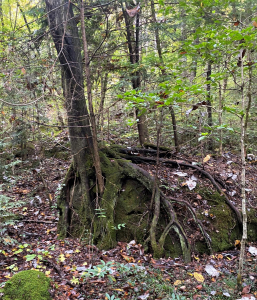
Sometimes, we take root on quarters that prove only temporarily hospitable, leaving us with no options but to find alternative means of surviving and succeeding. We’ve met and admired human survivors of such circumstances. Black birch, I have discovered, are masters at overcoming what to us appear as bad decisions. This individual, with its flaming yellow/orange foliage suspended over the creek, perseveres.
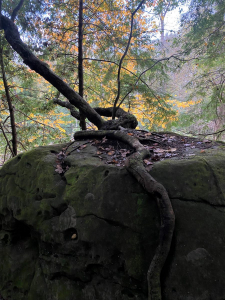
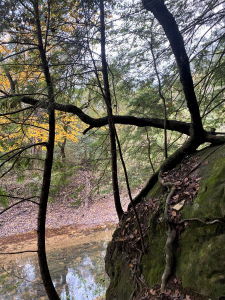
As does this individual perched 20 feet above mineral soil.
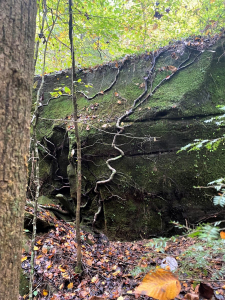
Bigleaf magnolia boasts the largest simple leaves of any tree native to North America. Josh provided scale for this one.
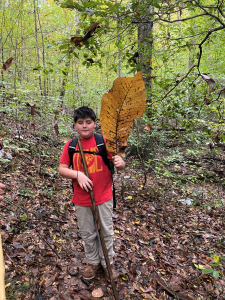
A rather contorted bigleaf magnolia rewarded us. Always on the lookout for wildlife, I was pleasantly surprised to find a hiker-tolerant, bigleaf magnolia antelope along the trail. Einstein observed:
Logic will get you from A to Z; imagination will get you everywhere.
Imagination hikes every trail at my side…and in my heart.
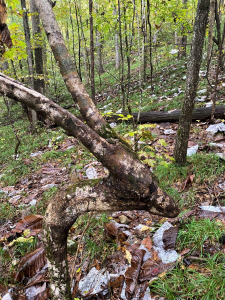
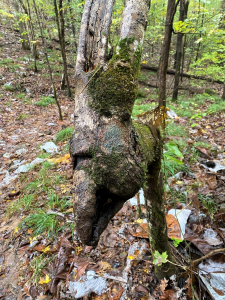
Nature never fails to reward those dedicated to finding gifts that lie hidden in plain sight.
Thoughts and Reflections
I offer these observations:
- Nature presents novices like me a lifetime of learning every time I venture into the wild.
- There are only two ways to live your life. One is as though nothing is a miracle. The other is as though everything is a miracle. Albert Einstein
- Look deep into nature, and then you will understand everything better. Einstein
Inhale and absorb Nature’s elixir. May Nature Inspire, Inform, and Reward you!
Note: All blog post images created & photographed by Stephen B. Jones unless otherwise noted. Please circulate images with photo credit: “©2021 Steve Jones, Great Blue Heron LLC. All Rights Reserved.”
Another Note: If you came to this post via a Facebook posting or by another route, please sign up now (no cost… no obligation) to receive my Blog Post email alerts: http://eepurl.com/cKLJdL
And a Third: I am available for Nature-Inspired Speaking, Writing, and Consulting — contact me at steve.jones.0524@gmail.com
Reminder of my Personal and Professional Purpose, Passion, and Cause
If only more of us viewed our precious environment through the filters I employ. If only my mission and vision could be multiplied untold orders of magnitude:
Mission: Employ writing and speaking to educate, inspire, and enable readers and listeners to understand, appreciate, and enjoy Nature… and accept and practice Earth Stewardship.
Vision:
- People of all ages will pay greater attention to and engage more regularly with Nature… and will accept and practice informed and responsible Earth Stewardship.
- They will see their relationship to our natural world with new eyes… and will understand more clearly their Earth home.
Tagline/Motto: Steve (Great Blue Heron) encourages and seeks a better tomorrow through Nature-Inspired Living!
Steve’s Three Books
I wrote my books Nature Based Leadership (2016), Nature-Inspired Learning and Leading (2017), and Weaned Seals and Snowy Summits: Stories of Passion for Place and Everyday Nature (2019; co-authored with Dr. Jennifer Wilhoit) to encourage all citizens to recognize and appreciate that every lesson for living, learning, serving, and leading is either written indelibly in or is powerfully inspired by Nature.
I began authoring books and Posts for several reasons:
- I love hiking and exploring in Nature
- I see images I want to (and do) capture with my trusty iPhone camera
- I enjoy explaining those images — an educator at heart
- I don’t play golf!
- I do love writing — it’s the hobby I never needed when my career consumed me
- Judy suggested my writing is in large measure my legacy to our two kids, our five grand kids, and all the unborn generations beyond
- And finally, perhaps my books and Blogs could reach beyond family and touch a few other lives… sow some seeds for the future


All three of my books (Nature Based Leadership; Nature-Inspired Learning and Leading; Weaned Seals and Snowy Summits) present compilations of firsthand experiences expressing my (and co-author Dr. Wilhoit for Weaned Seals and Snowy Summits) deep passion for Nature. All three books offer observations and reflections on my relationship to the natural world… and the broader implications for society. Order from your local indie bookstore, or find them on IndieBound or other online sources such as Amazon and LifeRich.

